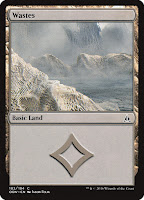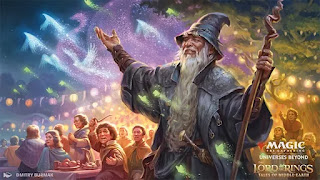 |
| catalog card art |
I conclude my self-imposed 'rules month' with a look at ability words.
Some time ago, I wrote on the different types of abilities. From the comprehensive rules,
113.1a An ability can be a characteristic an object has that lets it affect the game. An object’s abilities are defined by its rules text or by the effect that created it . . . Abilities generate effects.
(Note "can be." I provide the most common way the word 'ability' is used in Magic above; peruse the others in Section 113 of the rules if you wish.) Today's focus, ability words, are a little different.
From the glossary of the rules, we see Ability Word defined as:
"An italicized word with no rules meaning that ties together abilities on different cards that have similar functionality. See rule 207.2c."
We'll do as they suggest and see rule 207.2c:
207.2c An ability word appears in italics at the beginning of some abilities. Ability words are similar to keywords in that they tie together cards that have similar functionality, but they have no special rules meaning and no individual entries in the Comprehensive Rules. The ability words are adamant, addendum, alliance, battalion, bloodrush, channel, chroma, cohort, constellation, converge, council’s dilemma, coven, delirium, domain, eminence, enrage, fateful hour, ferocious, formidable, grandeur, hellbent, heroic, imprint, inspired, join forces, kinship, landfall, lieutenant, magecraft, metalcraft, morbid, pack tactics, parley, radiance, raid, rally, revolt, spell mastery, strive, sweep, tempting offer, threshold, undergrowth, and will of the council.
For example, here are some cards with the landfall ability word, all from the Zendikar Rising set:
There is a common element here—landfall always means "Whenever a land enters the battlefield under your control,"—but the effect that triggers whenever this condition is met can be very different. It can plus up creatures, add mana, make an opponent mill cards, create tokens, and more. Because the effect is different, it must be written out on each card; it cannot be omitted due to expected familiarity like keywords. This being the case, why have ability words at all?
I repeat, if ability words have no special rules meaning, why have them at all? Wizards answered this in a 2008 article. Their reasons, summarized, are:
- They connect cards,
- They provide a name,
- They add flavor,
- They help us market the set.
'Connecting cards' is key when creating synergies during deck building. If you want to build a 'landfall' deck, you would look for cards that had something happen when a land entered the battlefield. Ability words make it easier to search for such cards.
Providing a name is something Magic players would do on their own if Wizards didn't, for reason one: names help people connect cards.
Adding flavor is a way to enhance the gameplay experience while not impacting the rules at all. Marketing the set is related; you can convey the flavor of a set to help people understand (and, hopefully, desire) the nature of a forthcoming release.
Ability words used to confuse me, but I get them now. They serve several useful purposes.






























